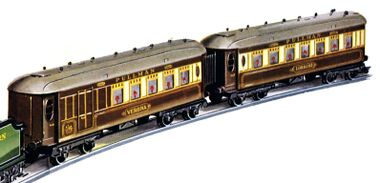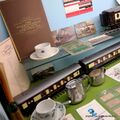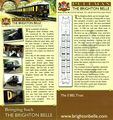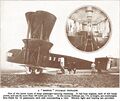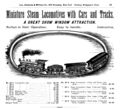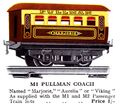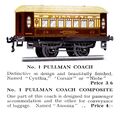Category:Pullman
Pullman crest, British Pullman railway carriage side-transfer [image info]
Pullman car model, detail, Jouet de Paris [image info]
1925 advert: "To Edinburgh by Pullman" [image info]
1925 advert: "Pullman and Perfection" [image info]
1925: "The First Pullman in England", Hornby [image info]
1926: Pullman Saloon Car interior [image info]
1926: Pullman Saloon Car interior [image info]
1928: New LNER Pullman Sevices: "The Queen of Scots", "The West Riding Pullman", "The Harrogate Sunday Pullman" [image info]
1929: Hornby No.1 Special Pullman coach, Arcadia [image info]
1930: Inexpensive toy railway carriages benefiting from the Pullman glamour, Hornby [image info]
1935: Bassett-Lowke Pullman cars in gauge 0, Hazel [image info]
1935: Dinky Toys, Pullman Staff [image info]
1938: Hornby No.2 Special Pullman coaches, Hazel and Verona [image info]
1961: Pullman Cars for Hornby Dublo [image info]
2013: Hornby No.2 Special Pullman carriage, colouring-in sheet (Chris Littledale) [image info]
2015: Oval Pullman lavatory window, mounted on an illuminated display box at Brighton Modelworld [image info]
Engraved crest, British Pullman railway carriage pot [image info]
1920: Triplane airliner designed for a Pullman air service [image info]
George Mortimer Pullman (1831-1897) was the American inventor-industrialist who created the luxury "Pullman car" railway carriages that became a feature of the US, British and Continental European railway networks.
Coffins and hotels and railways
George Pullman's career was a fairly improbable one that let him combine an odd set of specialisms to become a railway-carriage mogul.
Pullman got his start building coffins for the funeral trade, and also helped his father with work on the Erie Canal project. Since the canal needed to be level, this involved raising the ground level in some areas with embankments, and this meant that some nearby buildings had to be "lifted". This was achieved by physically "jacking them up" on extendable supports - the buildings were "cut" horizontally and physically raised up off their foundations, and the gap then filled in with brickwork or other architectural work.
George Pullman then moved from New York to Chicago just as the city needed to put in a long-overdue sewerage system. Chicago's problem was that ground level wasn't too much higher than the level of the river that ran through the city, which meant that underground sewers (or basements) weren't possible. However, Chicago was experiencing a glut of money from its business as a railway hub and meat-processing centre, and the city's extreme solution was to use a similar "jacking up" method to raise its city buildings by one storey, and then raise the level of the roads running between them to match. As one of the few people with previous experience of this sort of work, Pullman became one of the engineers responsible for "lifting" hotels and civic buildings.
As an inventor, Pullman was naturally attracted to the engineering possibilities offered by the booming railway business. Seeing businessmen coming and going at Chicago's main station to do deals, and spending a lot of money to stay at expensive hotels, he realised that these long-distance business travellers would be happy to spend a fair amount of money to make the long journey to Chicago less arduous, so that they could arrive refreshed and in the right state of mind to make deals. Could one not turn a set of railway carriages into a hotel on wheels? Pullman's study of hotel buildings for the Chicago project, combined with a personal familiarity with wood-panelling (and perhaps, a recollection of the long, thin, "packet boats" that ran on the Erie canal) resulted in his designing the first of the new Pullman railway cars based on the concept of a mobile hotel on rails, the Palace Car of 1864. His knowledge of the funeral industry also came in handy when President Abraham Lincoln was shot in 1865, and Pullman scored the public relations coup of organising the President's body to be slowly moved across the country "in state" as a sort of funeral procession, in a special train, in a Pullman railway car.
Developing the concept
Pullman's business flourished, and he introduced other "non-railway" concepts to the railway industry. A hotel would be inefficient without passageways that let staff and guests move between its parts, so why couldn't the same be done for Pullman cars? And a great hotel often had a great restaurant, so why not include one of those, too? Pullman introduced and patented the concept of vestibuled sections connecting carriages together, and introduced a sleeper car with an attached Kitchen and restaurant section, the President, in 1867. This was followed by the Delmonico restaurant car, manned by staff from Delomonico's restaurant, New York.
Pullman joined the board of Union Pacific in 1871, and as the business expanded, Pullman set up a private town for his employees, named Pullman, but labour unrest when the business contracted, coupled with the authoritarian method in which the town was administered, led to civil unrest, the Pullman Strike of 1894 that paralysed the country's rail network, and a investigating Government commission that concluded that the town should be released from Pullman's control and allowed to merge with the rest of the growing city of Chicago.
The Pullman company became Pullman-Standard in 1930.
Pullman in Britain (and Brighton)
George Pullman was invited to Britain in 1873 by the Midland Railway, who added eighteen Pullman cars to their rolling stock, and the Great Northern Railway followed with a Pullman Car on one of their services, with other railways "dipping a toe" into the idea of a Pullman option on some services, including the London, Brighton and South Coast Railway (LBSCR) in 1875.
The LBSCR embraced the Pullmans and introduced a four-car all-Pullman Pullman Limited Express in 1881. They added new vestibuled "Pullman Pups" cars, and the 1898 London-Brighton Pullman service became the Brighton Limited in 1899. This was followed by the seven-car Southern Belle in 1908 ("The Most Luxurious Train in the World"), which originated the classic brown and cream Pullman livery (Pullmans had previously normally been brown with gold lining).
The Southern Belle was also the first British Pullman train to be built in the UK (rather than assembled in the UK from parts shipped from America), and other all-Pullman services started to spring up around the country, including the Bournemouth Belle, the Flèche d'Or (Golden Arrow), the Continental Boat Express, and many others. Brighton's Southern Belle was replaced by the new all-electric Brighton Belle in 1934.
British Pullman carriages were serviced at a works just up the line from Brighton Station, at Preston Park.
1925 advertising text:
The Maximum of Luxury at the Minimum of Cost
"PULLMAN" and "PERFECTION"
are synonyms when they refer to Car Building, in which art the Pullman Car Company leads the world. In elaborate design, substantial construction, and luxurious finish, Pullman Cars represent the highest standard of excellence.
Ingenuity and skill are constantly being applied to the improvement of details with a view to adding to the comfort of travel. Every car is in charge of an experienced well-trained Conductor, whose services are always at hand from start to finish of a journey, and invalids and ladies with children can always rely upon ready attention to their comfort and convenience.
Cleanliness is also a special feature, coupled with perfect ventilation and good lighting, thus making travelling a real luxury.
Pullman Drawing Room, Buffet, Dining and Observation Cars are in operation on the following important lines:–
- Southern Railway
- L.B.&S.C.R Section: Victoria and London Bridge to Brighton, Hove, Worthing, Eastbourne, Bognor, Newhaven, Portsmouth, &c.
- S.E. & C. Section: Victoria and Charing Cross to Dover and Folkestone in all the Continental Services. Also Deal, Ramsgate, Margate, and Kent Coast Towns.
- London and North Eastern Railway
- Gt. Eastern Section: Buffet cars from Liverpool Street. First Class on Continental Trains.
- Gt. Northern and North-Eastern Section: King's Cross to Leeds, Harrogate, Ripon, Bradford, Darlington, Newcastle, Nottingham and Sheffield.
- London, Midland and Sottish Railway
- Glasgow & Edinburgh to Aberdeen, Oban, Perth, Stirling, Gleneagles, Danblane, Forfar, Callander, Lockerbie, Loch Awe, Carstairs, Beattock, Carlisle, Ayr, Turnberry and Stranraer, Blair-Atholl, Newtonmore, Kingussie, Kincraig, Aviemore, &c.
- Metropolitan Railway
- Buffet cars are run between Aldgate, Liverpool Street, Baker Street, Aylesbury, Chesham, and Verney Junction.
— , The Pullman Car Company Ltd., , The Railway Magazine, , January 1925
THE FIRST PULLMAN IN ENGLAND
IN George Stephenson's time railway carriages were built on somewhat similar lines to road coaches. Stephenson's first carriage, which he appropriately named the "Experiment", was more like a bathing machine than a railway carriage! It is difficult for travellers of the present day to realise the immense improvements that have taken place since the time when outside passengers were carried, and the tops of the coaches were heaped with luggage.
In this connection one of the most interesting of recent railway developments in Great Britain is the considerable increase in the number of Pullman cars. There are now more than 185 trains to which Pullman cars are attached, and some of these trains undoubtedly represent the height of luxury in railway travelling.
Pullman cars were originated by an American inventor, George Mortimer Pullman, who built the first sleeping car at Chicago in 1859. Four years later he produced the forerunner of the now famous type of railway coach which bears his name. Pullman cars were first introduced in this country by the Midland Railway in 1874.
— , Meccano Ltd., , The Hornby Book of Trains, , 1925
1935 description:
Luxury accommodation is provided in Great Britain by the independent Pullman Car Company, which owns a large number of cars, both first-class and third-class, and pays a rental to the railway companies concerned for their inclusion in the trains. The Pullman Car Company then charges a small supplement to all passengers using the cars, and also derives revenue from the catering. The only trains composed exclusively of Pullman stock in Great Britain are the "Queen of Scots Pullman" and the "Yorkshire Pullman" on the L.N.E.R., and the "Brighton Belle" and the "Bournemouth Belle" on the Southern Railway. The "Brighton Belle" is claimed to be the only electrically-operated multiple-unit Pullman car train in the world. But the majority of the express trains between London and Margate, Ramsgate, Folkestone, Dover, Deal, Hastings, Eastbourne, Brighton, and Worthing carry Pullman cars in their formations. They are run, also, in the boat trains of the L.N.E.R. to and from Parkeston Quay (Harwich), in those of the Southern to and from Southampton, Dover, and Folkestone, and on certain other services.
— , -, , MODERN PASSENGER ROLLING STOCK: Luxury and Comfort in Today's Rail Transport, , Railway Wonders of the World, , 1935
Further reading
- Charles Fryer British Pullman Trains: A tribute to all Britain's steam, diesel and electric Pullman services (Silver Link Publishing Ltd., 1992) ISBN 0947971785
- Antony M Ford Pullman Profile No 1, The 12-Wheel Cars (Noodle Books, 2008) ISBN 9781906419004
- George Behrend Pullman in Europe (Ian Allan Ltd)
- Don Carter, Joe Kent and Geoff Hart Pullman Craftsmen: Life in the Pullman Car Company's Preston Park Works, Brighton 1947-1963: A view from the shop floor (QueenSpark Book 27) ISBN 0904733505
- Ivan Broadhead Pullman Past and Present Meccano Magazine, October 1961
External links
Subcategories
This category has the following 21 subcategories, out of 21 total.
5
B
- Blue Pullman (2 P, 12 F)
- Bournemouth Belle (2 P, 4 F)
- Brighton Belle (display) (25 P, 4 F)
- Brighton Belle Mural (6 F)
C
G
- Green and cream Pullmans (4 F)
H
- Hornby No2 Special Pullman Coaches (10 P, 8 F)
N
- Named Pullman carriages (23 P, 22 F)
O
P
- Preston Park Pullman Works (1 P, 4 F)
R
- Rheingold (1 P, 6 F)
S
U
- Union Pacific M-10000 streamliner (2 P, 9 F)
Pages in category ‘Pullman’
The following 79 pages are in this category, out of 79 total.
A
B
- Barnstaple Pullman train set 2035 (Hornby Dublo)
- Blue Pullman carriage (Hornby Series)
- Blue Pullman Train Set (Tri-ang RS52)
- Brenda Pullman carriage (Bond's of Euston Road)
- Brighton Belle (Darstaed gauge 0)
- Brighton Belle 1934 Pullman train (Hornby, 2012)
- Brighton Belle 1969 Pullman train (Hornby 00)
- Brighton Belle Bill of Fare
- Brighton Belle car, Joan, gauge 1 (John Clegg)
- Brighton Belle ceramic mugs
- Brighton Belle Commemorative Postal Cover (30 April 1972)
- Brighton Belle Last Day Service carried postal cover (30 April 1972)
- Brighton Belle leaflet, front
- Brighton Belle Pullman electric cars 90 and 91 (Wrenn W3006 W3007)
- Brighton Belle – Bournemouth Belle fold-out brochure
- Brighton Belle – Pullman tickets set
C
F
G
M
P
- Pullman 12-wheel Dining Saloon 13210 (Georges Carette for Bassett-Lowke, gauge 1)
- Pullman Brighton Belle Car 90 (Wrenn 3006)
- Pullman Brighton Belle Car 91 (Wrenn 3007)
- Pullman Car side mockup, Doris (5BEL)
- Pullman Carriage Doris, backdrop
- Pullman carriages (Hornby Series)
- Pullman coach, Aurelia (Hornby M1 gauge 0)
- Pullman coach, Marjorie (Hornby M1 gauge 0)
- Pullman Dining Car, green (Hornby Series)
- Pullman embroidered antimacassar
- Pullman first class car (Bing for Bassett-Lowke, gauge 1)
- Pullman first class car 1921 (Bing for Bassett-Lowke, gauge 1)
- Pullman Golden Arrow menu, cream leather sleeve
- Pullman menu, dark leather sleeve
- Pullman No2 coaches (Hornby Series)
- Pullman No2 Special Coach (Composite), Alberta (Hornby Series)
- Pullman No2 Special Coach (Composite), Arcadia (Hornby Series)
- Pullman No2 Special Coach (Composite), Arcadia, A37 (Hornby Series)
- Pullman No2 Special Coach (Composite), Verona (Hornby Series)
- Pullman No2 Special Coach, Grosvenor (Hornby Series)
- Pullman No2 Special Coach, Iolanthe (Hornby Series)
- Pullman No2 Special Coach, Iolanthe, A37 (Hornby Series)
- Pullman No2 Special Coach, Loraine (Hornby Series)
- Pullman No2 Special Coach, Zenobia (Hornby Series)
- Pullman Passenger Train Set, Loco 3435 (Hornby Trains
- Pullman Services Tickets (Brighton Belle)
- Pullman sugar-shaker
- Pullman table-lamp
- Pullman TRIX TWIN Saloon Car (Trix Twin Railway 598)
- Pullman Works, photograph
T
Media in category ‘Pullman’
The following 148 files are in this category, out of 148 total.
- 5BEL Pullman Car stage backdrop, disassembled.jpg 969 × 563; 43 KB
- 5BEL Trust stand with Dalek (Brighton Modelworld 2016).jpg 1,800 × 1,200; 1.27 MB
- 5BEL Trust, logo.gif 189 × 52; 7 KB
- Accessway, Preston Park Loco Works (Brighton 2018).jpg 1,600 × 1,067; 1,016 KB
- Arcadia, Hornby No1 Special Pullman Coach (TRM 1929-03).jpg 2,860 × 1,850; 2.24 MB
- Area 86.jpg 1,200 × 1,199; 730 KB
- Bing Electric Express Train (BTC).jpg 1,407 × 695; 218 KB
- Blue Pullman Diesel Motor Cars, powered and unpowered, R-555 and R-556 (TR 1963).jpg 3,000 × 1,166; 1.58 MB
- Blue Pullman Parlour Car, Tri-ang R-426 (TR 1964).jpg 2,467 × 904; 972 KB
- Blue Pullman Train Set, Tri-ang RS-52 (TR 1964).jpg 4,592 × 1,431; 2.79 MB
- Blue Pullman, Meccano Magazine cover (MM 1960-10).jpg 813 × 1,200; 743 KB
- Brighton Belle 'Joan' car detail (Clegg).jpg 1,024 × 768; 524 KB
- Brighton Belle book.jpg 333 × 381; 28 KB
- Brighton Belle Bournemouth Belle, carriage layout (BB-BBl).jpg 4,000 × 1,697; 1.25 MB
- Brighton Belle Bournemouth Belle, services and fares (BB-BBl).jpg 1,873 × 2,200; 614 KB
- Brighton Belle ceramic mugs.jpg 1,200 × 800; 499 KB
- Brighton Belle crack electric express (RWW 1935).jpg 3,000 × 1,574; 2.44 MB
- Brighton Belle due 2015 leaflet (5BELTrust 2014).jpg 1,133 × 1,600; 1.37 MB
- Brighton Belle Last Run 50th Anniversary.jpg 1,938 × 3,000; 1.51 MB
- Brighton Belle leaflet (5BEL Trust ~2013).jpg 882 × 1,238; 179 KB
- Brighton Belle leaflet, brown and cream (5BEL Trust).jpg 1,883 × 2,000; 3.14 MB
- Brighton Belle leaflet, interior (5BEL Trust ~2013).jpg 2,340 × 1,648; 823 KB
- Brighton Belle Mural and Terry Smith.jpg 1,612 × 1,265; 378 KB
- Brighton Belle Mural, early sketch.jpg 1,173 × 683; 126 KB
- Brighton Belle Mural, partial.jpg 1,620 × 2,160; 2.07 MB
- Brighton Belle plaque.jpg 2,048 × 1,536; 565 KB
- Brighton Belle Poster (2022-04-030.jpg 2,121 × 2,999; 1.16 MB
- Brighton Belle Pullman ticket A151002 (1971-12-04).jpg 1,200 × 782; 353 KB
- Brighton Belle Pullman with George IV, cover art, Aubrey Hammond (BrightonHbk 1939).jpg 2,500 × 1,522; 2.41 MB
- Brighton Belle set, box end (Wren W3004-5).jpg 1,600 × 563; 195 KB
- Brighton Belle set, box top (Wren W3004-5).jpg 2,400 × 910; 352 KB
- Brighton Modelworld 2015, 5BEL Trust stand, setting up.jpg 1,800 × 1,070; 1.09 MB
- Brighton or Bournemouth in Pullman Luxury (BB-BBl).jpg 1,018 × 1,200; 401 KB
- Bristol Pullman passenger triplane (WBoA 4ed 1920).jpg 3,000 × 2,523; 1.49 MB
- Colouring-in sheet - Pullman Carriage.jpg 3,508 × 2,482; 1.32 MB
- Damaged Pullman Vestibule, The History of the Pullman Car (TRM 1898).jpg 1,774 × 2,200; 972 KB
- Diesel Pullmans (TRM 1960-12).jpg 1,051 × 1,800; 1.12 MB
- Down Brighton Belle passing Clapham Junction (RWW 1935).jpg 3,000 × 1,305; 1.98 MB
- Edinburgh Pullman Express, LNER 2549 Persimmon, entering Hadley Tunnel (WBoR 13ed 1925).jpg 3,000 × 2,378; 5.16 MB
- Entrance gate for Preston Park Works (Brighton 2018).jpg 1,600 × 1,067; 1.05 MB
- Evaluating old paintwork (Bonds Brighton Belle restoration project).jpg 2,800 × 1,867; 728 KB
- George Pullman, The History of the Pullman Car (TRM 1898).jpg 1,769 × 2,200; 773 KB
- Gladiolus Palace Car, The History of the Pullman Car (TRM 1898).jpg 2,200 × 1,181; 662 KB
- Golden Arrow - Flèche d'Or railway carriage 4751, detail (Jouet de Paris).jpg 1,200 × 900; 654 KB
- Hazel Pullman car, electric London-Brighton service (MM 1933-02).jpg 3,291 × 1,344; 2.79 MB
- Hazel Pullman Car, gauge 0, Bassett-Lowke (MM 1935-09).jpg 3,000 × 980; 1.37 MB
- Heavy-duty Bonds electric bogie (Bonds Brighton Belle restoration project).jpg 2,200 × 1,467; 682 KB
- Her Majesty Pullman Palace Car, LBSCR, The History of the Pullman Car (TRM 1898).jpg 2,200 × 1,875; 1.07 MB
- Hornby 'Golden Arrow' No3 train set (HBoT 1938).jpg 3,041 × 1,641; 592 KB
- Hornby Brighton Belle R2987 pack back.jpg 1,280 × 710; 190 KB
- Hornby Brighton Belle R2987 pack front.jpg 1,280 × 710; 171 KB
- Hornby E120 Special Passenger Train (1939- catalogue).jpg 2,371 × 753; 502 KB
- Hornby M0 Pullman Coaches, Zena, Joan (HBoT 1930).jpg 1,373 × 691; 164 KB
- Hornby M1 Pullman Coaches, Marjorie, Aurelia (HBoT 1930).jpg 2,789 × 1,469; 572 KB
- Hornby No.2 Pullman Set, LMS (1925 HBoT).jpg 1,990 × 821; 273 KB
- Hornby No.2 Pullman Set, LNER (1925 HBoT).jpg 2,052 × 741; 304 KB
- Hornby No2 Pullman Set, GW (1926 HBoT).jpg 1,925 × 731; 189 KB
- Hornby No2 Pullman Set, LNER (1926 HBoT).jpg 2,037 × 624; 180 KB
- Hornby No2 Special Pullman Coaches, Arcadia and Loraine (HBoT 1934).jpg 3,525 × 733; 418 KB
- Hornby Series M Passenger Set (1926 HBoT).jpg 1,888 × 749; 233 KB
- Hornby US Pullman Car, (HBoT 1930).jpg 1,685 × 1,221; 281 KB
- Hornby US Pullman or European Mitropa Car (HBoT 1931).jpg 858 × 638; 156 KB
- Ives train set with Pullman Palace Car, trade advert (1890s).jpg 2,374 × 2,153; 680 KB
- JS Marks, The History of the Pullman Car (TRM 1898).jpg 1,424 × 2,200; 778 KB
- Lionel 752 M-10000 streamliner locomotive.jpg 1,024 × 768; 418 KB
- Lionel 753 M-10000 streamliner passenger car.jpg 1,024 × 578; 304 KB
- Lionel 754 M-10000 streamliner end car.jpg 1,024 × 576; 354 KB
- Lionel Electric Trains (MM 1935-11).jpg 1,519 × 1,081; 348 KB
- Lionel Trains (MM 1936-10).jpg 2,309 × 1,446; 604 KB
- Luxury on the Line, Blue Pullman Train Set (TriangMag 1965-04).jpg 2,352 × 3,000; 2.23 MB
- M10000 streamliner train (Marx).jpg 1,200 × 300; 222 KB
- M10000 streamliner train, front detail (Marx).jpg 1,200 × 370; 268 KB
- M10000 streamliner train, rear detail (Marx).jpg 1,200 × 342; 248 KB
- Mary First Class Pullman carriage, Tri-ang Railways R-228 (TRCat 3rd 1957).jpg 2,000 × 1,219; 1.13 MB
- Midland Pullman Kitchen Car, box lid (Kitmaster 32).jpg 2,200 × 751; 1.47 MB
- Midland Pullman Kitchen Car, instructions (Kitmaster No32).jpg 1,838 × 2,200; 1.39 MB
- Midland Pullman Power Car, box lid, flat (Kitmaster 31).jpg 2,400 × 1,082; 2.28 MB
- Mural of Famous Train pulls in rail enthusiasts (The Argus, 2010-09).jpg 1,600 × 1,210; 579 KB
- New Pullman Services, LNER (TRM 1928-05).jpg 830 × 1,200; 263 KB
- Oval Pullman window, mounted on illuminated display box.jpg 1,775 × 2,000; 2.15 MB
- Preliminary seating layout test (Bonds Brighton Belle restoration project).jpg 1,800 × 1,200; 901 KB
- Preston Park Pullman Works site (Brighton 2018).jpg 3,000 × 2,000; 3.3 MB
- Pullman Administration Building, The History of the Pullman Car (TRM 1898).jpg 2,200 × 1,193; 739 KB
- Pullman and Perfection (TRM 1925-01).jpg 1,678 × 2,500; 1.41 MB
- Pullman and Perfection, Burtt and Beckerlegge, Baldwin front cover (1948).jpg 1,051 × 1,600; 522 KB
- Pullman Car 1st Class, Aries, Hornby Dublo 4035 (DubloCat 1963).jpg 1,661 × 653; 190 KB
- Pullman Car 2nd Class, Hornby Dublo 4036 (DubloCat 1963).jpg 1,675 × 683; 202 KB
- Pullman Car after Collision, The History of the Pullman Car (TRM 1898).jpg 2,200 × 1,440; 953 KB
- Pullman Car Brake-2nd Class, Hornby Dublo 4037 (DubloCat 1963).jpg 1,595 × 691; 201 KB
- Pullman Car Brenda (Bond's of Euston Road).jpg 1,200 × 677; 413 KB
- Pullman Car Brenda, pic2 (Bond's of Euston Road).jpg 1,200 × 675; 501 KB
- Pullman Car CIWL 4025 (French Hornby).jpg 1,200 × 675; 591 KB
- Pullman car oval window on board, angle view (5BEL 2014).jpg 1,200 × 1,600; 1.06 MB
- Pullman car oval window on board, front view (5BEL 2014).jpg 1,200 × 1,600; 1.01 MB
- Pullman Car, Third Class, Märklin 2890-0 (MarklinCRH ~1925).jpg 2,630 × 1,277; 1.01 MB
- Pullman carriage embroidered antimacassar.jpg 1,200 × 675; 437 KB
- Pullman carriages (Milbro).jpg 1,600 × 714; 141 KB
- Pullman carriages, No2, green (HBoT 1925).jpg 2,548 × 1,208; 451 KB
- Pullman Cars (Milbro 1930).jpg 2,641 × 1,488; 587 KB
- Pullman Cars, Hornby Dublo (MM 1961-09).jpg 2,431 × 3,000; 4.63 MB
- Pullman Cars, Tri-ang Wrenn W6000 W6001 W6002 (TWSupp 1972).jpg 3,000 × 2,307; 1.01 MB
- Pullman Coach CIWL, 00 gauge, Märklin 349 (Marklin00CatGB 1937).jpg 1,573 × 825; 566 KB
- Pullman Coach Composite No.1, Hornby Series (1928 HBoT).jpg 832 × 586; 84 KB
- Pullman Coach Composite No.2-3, Hornby Series (1928 HBoT).jpg 967 × 631; 103 KB
- Pullman Coach green, 00 gauge, Märklin 349E (Marklin00CatGB 1937).jpg 1,535 × 825; 574 KB
- Pullman Coach No.1, Hornby Series (1928 HBoT).jpg 841 × 595; 78 KB
- Pullman Coach No.2-3, Hornby Series (1928 HBoT).jpg 921 × 533; 88 KB
- Pullman coach, Hazel, B-L exhibition model (MRH12ed 1942).jpg 1,451 × 1,168; 311 KB
- Pullman Composite Coach, 00-gauge, Graham Farish (GF 1964).jpg 2,425 × 1,159; 343 KB
- Pullman Craftsmen, book (Queenspark27 ISBN 0904733505).jpg 885 × 1,200; 365 KB
- Pullman crest, lowquality.jpg 853 × 688; 103 KB
- Pullman Dining Car, 00-gauge, Graham Farish (GF 1964).jpg 2,431 × 1,158; 349 KB
- Pullman engraved crest.jpg 2,004 × 1,121; 1.34 MB
- Pullman M1 Coach, Hornby Series (HBoT 1931).jpg 781 × 692; 155 KB
- Pullman No.1 Coach, Hornby Series (HBoT 1931).jpg 840 × 793; 173 KB
- Pullman No.2 Coach, Hornby Series (HBoT 1931).jpg 973 × 538; 135 KB
- Pullman No.2 Special Coach Composite, Hornby Series (HBoT 1931).jpg 956 × 582; 160 KB
- Pullman No.2 Special Coach, Hornby Series (HBoT 1931).jpg 971 × 569; 153 KB
- Pullman No2 Special Coaches, Verona and Loraine (HBoT 1938).jpg 1,591 × 767; 168 KB
- Pullman Passenger Car TMNR11, dimensions (TMNRBroc 1963).jpg 3,000 × 2,200; 491 KB
- Pullman Passenger Car TMNR11, Emerald, overview (TMNRBroc 1963).jpg 3,654 × 2,025; 1.34 MB
- Pullman Passenger Car TMNR11, seating layout (TMNRBroc 1963).jpg 2,000 × 1,203; 543 KB
- Pullman TRIX TWIN carriage (TTRcat 1939-).jpg 1,600 × 867; 158 KB
- Pullman-Limousine Body, for Car Construction Set, Märklin 1104PN (MarklinCat 1936).jpg 2,014 × 2,198; 2.19 MB
- Rheingold Car, Märklin 1749 1749-G (MarklinCat 1936).jpg 1,819 × 954; 321 KB
- Rheingoldwagen - Rheingold Passenger Carriage, Märklin 1758 (MarklinCat 1939).jpg 1,641 × 1,005; 620 KB
- Rheingoldwagen, Märklin 1749 (MarklinCat 1931).jpg 1,750 × 1,109; 979 KB
- Riviera Blue Train Coach, Hornby Series (1928 HBoT).jpg 971 × 567; 90 KB
- Saloon Car Interior, Birmingham (TRM 1926-12).jpg 2,200 × 1,446; 1.99 MB
- Saloon Car Interior, Metropolitan (TRM 1926-12).jpg 2,200 × 1,444; 1.93 MB
- Sleeping Car, Mitropa red, 00 gauge, Märklin 343 (Marklin00CatGB 1937).jpg 1,504 × 765; 521 KB
- Southern Belle leaving Victoria Station, postcard (F Moore).jpg 2,500 × 1,600; 3.3 MB
- Southern Belle Pullman Express poster.jpg 724 × 1,024; 173 KB
- Speeding Across a Continent, Union Pacific M-10000 locomotive (RWW 1935).jpg 3,000 × 2,161; 5.22 MB
- Testing sightlines (Bonds Brighton Belle restoration project).jpg 683 × 1,024; 274 KB
- The Blue Pullman, train set, box lid (Tri-ang Railways RS52).jpg 3,000 × 2,170; 5.79 MB
- The Midland Pullman, article (TriangMag 1965-04).jpg 800 × 511; 355 KB
- The New Golden Arrow Pullman Train (1951).jpg 1,609 × 2,000; 497 KB
- The Southern Belle, F Moore (WBoR 13ed ~1925).jpg 3,000 × 2,251; 5.62 MB
- TheBrightonBelle book.jpg 400 × 456; 42 KB
- Three New Hornby Trains, Hornby No.3 locomotives (MM 1927-12).jpg 929 × 1,200; 527 KB
- To Edinburgh by Pullman, advert (TRM 1925-09).jpg 1,025 × 1,600; 631 KB
- Train and Hotel Staff, Dinky Toys No 5 (1935 BHTMP).jpg 875 × 451; 52 KB
- Train Bleu and Fleche d'Or train sets No2-E, French Hornby (MFCat 1935).jpg 1,600 × 331; 100 KB
- Triang Railways, catalogue front cover (TRCat 1964).jpg 2,324 × 3,000; 4.89 MB












